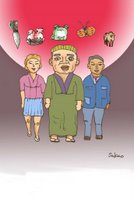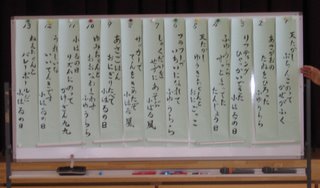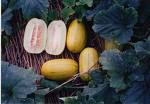:::::::::::::::::::::::::::::::::::::::::::::::::::::::::::::::::::::::::::::::::::::::::::::::::::::
Nandina Blossoms (nanten)
***** Location: Japan
***** Season: Mid-Summer
***** Category: Plant
*****************************
Explanation
NANDINA DOMESTICA Wood's Dwarf : nanten no hana, 南天の花
nan means south and ten is heaven or sky, southern sky.
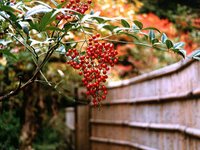
http://www.yunphoto.net/jp/photobase/yp212.html
nanten no hana 南天の花 (なんてんのはな)
hana nanten 花南天(はななんてん)
The Nanten plant (Nandina domestica or sacred bamboo)
is native to China but in Japan it is regarded as a member of the Japanese Barberry family of evergreen shrubs. It grows in forests with rich topsoil west of the Kanto region, and in our city it can be found mainly in the Amami and Nagaredani areas, growing around houses, rock walls and fields. Its flowering period lasts from June to July, and around December it bears bright red berries. It is used in flower arrangements for the New Year period, and also for medicinal purposes.
http://www.city.kawachinagano.osaka.jp/english/Amami.html
This evergreen small shrub grows to 1 to 2 feet tall and has intricate dissected leaves which give it a very lacy, almost fern-like, look. It is slower growing and much smaller than the species yet it still has the same bamboo cane-like stems and foliage colors. New foliage is reddish in color and during the fall the leaves turn an orange, bronze or purplish red. Pinkish white flowers bloom in clusters at the ends of branches in the late spring and summer. Plant in sun or shade and water occasionally. It will survive temperatures down to 10 degrees F.
The word Nandina is derived from "nanten", the Japanese name for the plant, and "domestica" meaning cultivated.
http://www.smgrowers.com/products/plants/plantdisplay.asp?strLetter=N&plant_id=2550&page
:::::::::::::::::::::::::::::::::::::::::::::::::::::::::::::::::::::::::::::::::::::::::::::::::::::::
Nanten, the plant sometimes known as "Heavenly bamboo", sounds the same as Chinese characters nan meaning "troubles", and ten meaning "to (over) turn", so it has gained an association with overcoming difficulties. This is rather as if in English-speaking countries we painted four people playing the flute, and said it meant "four-tune".
http://imaginatorium.org/shop/kaiun.htm
NANDIN
Because its name suggests the expression nan o tenzuru to overturn misfortune or adversity), nanten has traditionally been regarded as an auspicious plant. Warriors of old put its leave in their armor to ensure victory.
Nanten was also used as an alcove ornament for coming-of-age ceremonies (Genpuku), and pregnant women were known to place sprays of nanten under their coverlets to ensure a safe delivery.
http://www.yoursourceinjapan.com/motifs.htm
:::::::::::::::::::::::::::::::::::::::::::::::::::::::::::::::::::::::::::::::::::::::::::::::::::::::

"Comparison of Beauties and Flowers - Nandin"
Ogata Gekkō 尾形月耕 Ogata Gekko (1859-1920)
:::::::::::::::::::::::::::::::::::::::::::::::::::::::::::::::::::::::::::::::::::::::::::::::::::::::
Japanese love of the Nanten
Nandina domestica is indigenous to Japan. The Japanese name is NANTEN (= south sky), an abbreviated form of NANTENSEI (= stars of south sky). It bears red berries in winter, so I wonder if people in olden times compared its berries to the stars of the southern sky? It is a small evergreen tree that grows under forest trees. Its leaves become red in autumn and winter, so this tree is often planted in gardens as an ornamental tree.
In the late Edo Period (early 1800s), some enthusiasts found chimerical types with narrow and thin leaves and they appreciated such types as pot trees. These chimerical cultivars became popular in the early Meiji Period (late 1800s), about 180 cultivars were introduced in the catalog "NANTEN HINSHU" (Nandina domestica cultivars list, published in 1879).
These cultivars were called KINSHI NANTEN (= harp strings NANTEN) because enthusiasts compared the thin leaves to strings of Japanese harp. Later, most of the cultivars were lost, with only about 20-30 cultivars left at the present day.
More pictures are here:
http://homepage3.nifty.com/plantsandjapan/page105.html
::::::::::::::::::::::::::::::::::::::::::::::::::::::::::::::::::::::::::::::::::::::
During the Momoyama Period, Nandine became widely used as a flower for ikebana. In the Edo period, it was a favorite garden shrub of the rich townspeople with more than 120 varieties.
Nanten grows wild in our area, mostly in the place of the toilets of old. The farmers tell me it pleases the deity of the toilet.
I have written about the Japanese God of the Toilet and ways to appease him here
http://darumapilgrim.blogspot.com/2005/02/suijin-god-of-water.html
The bitter dryed fruit is used as a cough suppressant in the traditional Chinese medicine. And tree bark and rootage bark of it is used for the medicine of eye disease and stomach disorder.
Gabi Greve
*****************************
Worldwide use
*****************************
Things found on the way
The famous Zen priest Nantenbo (Nantembo) used a stick of this plant.
It was during his travels in Kyushu in 1873 that Nantenbō discovered a large nandina bush growing beside a cow shed. From the owner, he learned that it was an ancient growth.
Read the rest of my story about Nantenbo here:
http://darumapilgrim.blogspot.com/2005/04/nantenboo.html
:::::::::::::::::::::::::::::::::::::::::::::::::::::::::::::::::::::::::::::::::::::::::::::::::::::
Nanten (nandin or heavenly bamboo)
By LINDA INOKI, The Japan Times Nov. 16, 2005
Every variety of bird visited this garden at its appointed time of year, but nothing could compare to the numbers and din in the migration season, when flocks of birds swooped down from the sky to peck at the nandin fruits and the insects in the broad expanse of lawn.
From "After the Banquet" by Yukio Mishima translated by Donald Keene (Charles E. Tuttle)
One of the birds' favorite treats is the nandin (Nandina domestica), which produces gorgeous clusters of red berries in late autumn. Luckily for the birds, nandin, or heavenly bamboo, is popular with humans too. Nandin is a member of the barberry family and native to China and Japan. But since it is so graceful and easy to grow, it has become a popular shrub with Western gardeners too. In Japanese, nandin sounds like "nanten," which means "misfortune breaker," and for centuries it was planted in the northeastern corner of gardens or by the gate to ward off evil spirits.
In sunshine or shade it grows up to 2 meters high, and being resistant to pollution, it can grow in alleys or tiny curbside plots. In early summer, it bears panicles of small white buds that, no matter how often you look, never quite seem ready to open. The lacy, evergreen leaves take on a lovely coppery sheen in winter, and since they were believed to have purifying properties, they were used as a platter for offerings or gifts of fish. Nowadays, you are more likely to see the leaves on your plate as an artistic garnish in a Japanese restaurant. In the West, nandin berries are prized as Christmas decorations -- as long as the birds don't eat them first.
(C) All rights reserved The Japan Times
http://www.japantimes.co.jp/cgi-bin/getarticle.pl5?fe20051116li.htm
*****************************
HAIKU
赤い実を産む花白きナンテンに 清められんと佇んでおり
White flowers will bear red fruits
Nanten is the plant to purify
I stand under it for purification
http://www.kitada.com/keiko/calendar06.html
*****************************
Related words
***** Nandina Berries, Nandin Berries,
nanten no mi, mi nanten
南天の実、実南天
shiro nanten 白南天(しろなんてん)white nandina berries
kigo for all winter
The red berries are most beautiful and decorative in a white winter garden. Our birds usually come pick them in February or March, so I guess they are not so delicious for them.
Branches with Nandina berries are often used for the New Year's decoration, kadomatsu.
. WKD : New Year Decorations
Winter's sky is blue as blue can be,
and front of me, the red of nandin is very
clearly in the snow.
http://www.osaka-c.ed.jp/hirakata/kyoka/eigo/haiku.htm
...................................................
表札の煤(すす)けゐたりき実南天
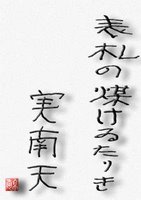
brushing off
the dust from the name plate -
red nandine berries
http://www.keiainet.com/kigo/kigo02.html
xxxxxxxxxxxxxxxxxxxxxxxxxxxxx

Photo Gabi Greve
red berries --
the magnolia and the heavenly bamboo
"chibi" (pen-name for Dennis M. Holmes)
Look at more photos here:
http://ohaga.blogspot.com/2005/11/nanten.html
:::::::::::::::::::::::::::::::::::::::::::::::::::::::::::::::::::::::::::::::::::::::::::::::::::::
red leaves
in the evening sun -
spring is a'comin
Gabi Greve, February 2007
Red Leaves 2007 PHOTOS !
:::::::::::::::::::::::::::::::::::::::::::::::::::::::::::::::::::::::::::::::::::::::::::::::::::::
. PLANTS in all seasons - SAIJIKI
:::::::::::::::::::::::::::::::::::::::::::::::::::::::::::::::::::::::::::::::::::::::::::::::::::::::::::::::::::::::::::
. Japanese Legends - 伝説 民話 昔話 – ABC-List .
.......................................................................
................................. Kumamoto 熊本県
ryuuguu sama 龍宮様
昔、むこが竜宮様にあげるために柴薪を海に投げ込んだら、竜宮様に感謝されお礼に金の糞をする猫をくれた。むこは金持ちになったが姑婆が猫を殺してしまった。むこが猫を埋めるとそこから黄金がなる南天が生えてきた。
................................. Shimane 島根県
出雲市 Izumo city 大塚町
. Nanten against poison .
.......................................................................
- reference : Nichibun Yokai Database -
25 南天 (02)
:::::::::::::::::::::::::::::::::::::::::::::::::::::::::::::::::::::::::::::::::::::::::::::::::::::::::::::::::::::::::::
[ . BACK to DARUMA MUSEUM TOP . ]
[ . BACK to WORLDKIGO . TOP . ]
- #nanten #nandina -
:::::::::::::::::::::::::::::::::::::::::::::::::::::::::::::::::::::::::::::::::::::::::::::::::::::::::::::::::::::::::::







